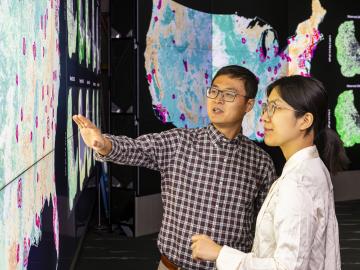Filter News
Area of Research
- Advanced Manufacturing (3)
- Biology and Environment (23)
- Clean Energy (49)
- Computational Engineering (1)
- Computer Science (5)
- Fusion and Fission (11)
- Fusion Energy (7)
- Isotope Development and Production (1)
- Isotopes (26)
- Materials (98)
- Materials for Computing (11)
- National Security (26)
- Neutron Science (19)
- Nuclear Science and Technology (22)
- Nuclear Systems Modeling, Simulation and Validation (1)
- Quantum information Science (4)
- Supercomputing (47)
News Topics
- (-) Advanced Reactors (33)
- (-) Big Data (50)
- (-) Critical Materials (24)
- (-) Cybersecurity (35)
- (-) Isotopes (46)
- (-) Microscopy (50)
- (-) Physics (58)
- (-) Polymers (31)
- (-) Space Exploration (24)
- 3-D Printing/Advanced Manufacturing (116)
- Artificial Intelligence (84)
- Bioenergy (88)
- Biology (95)
- Biomedical (57)
- Biotechnology (21)
- Buildings (54)
- Chemical Sciences (59)
- Clean Water (29)
- Climate Change (94)
- Composites (25)
- Computer Science (182)
- Coronavirus (46)
- Decarbonization (73)
- Education (3)
- Element Discovery (1)
- Emergency (2)
- Energy Storage (106)
- Environment (192)
- Exascale Computing (34)
- Fossil Energy (5)
- Frontier (39)
- Fusion (52)
- Grid (59)
- High-Performance Computing (82)
- Hydropower (11)
- Irradiation (3)
- ITER (7)
- Machine Learning (44)
- Materials (140)
- Materials Science (133)
- Mathematics (6)
- Mercury (12)
- Microelectronics (2)
- Molten Salt (8)
- Nanotechnology (60)
- National Security (56)
- Net Zero (11)
- Neutron Science (128)
- Nuclear Energy (103)
- Partnerships (40)
- Quantum Computing (28)
- Quantum Science (65)
- Renewable Energy (2)
- Security (23)
- Simulation (43)
- Software (1)
- Statistics (3)
- Summit (57)
- Sustainable Energy (119)
- Transformational Challenge Reactor (7)
- Transportation (93)
Media Contacts

Scientists at ORNL completed a study of how well vegetation survived extreme heat events in both urban and rural communities across the country in recent years. The analysis informs pathways for climate mitigation, including ways to reduce the effect of urban heat islands.

A collection of seven technologies for lithium recovery developed by scientists from ORNL has been licensed to Element3, a Texas-based company focused on extracting lithium from wastewater produced by oil and gas production.

Scientists at Oak Ridge National Laboratory and six other Department of Energy national laboratories have developed a United States-based perspective for achieving net-zero carbon emissions.

Groundwater withdrawals are expected to peak in about one-third of the world’s basins by 2050, potentially triggering significant trade and agriculture shifts, a new analysis finds.

Rigoberto “Gobet” Advincula, a scientist with joint appointments at ORNL and the University of Tennessee, has been named a Fellow of the American Institute for Medical and Biological Engineering.

A first-ever dataset bridging molecular information about the poplar tree microbiome to ecosystem-level processes has been released by a team of DOE scientists led by ORNL. The project aims to inform research regarding how natural systems function, their vulnerability to a changing climate and ultimately how plants might be engineered for better performance as sources of bioenergy and natural carbon storage.

Canan Karakaya, a R&D Staff member in the Chemical Process Scale-Up group at ORNL, was inspired to become a chemical engineer after she experienced a magical transformation that turned ammonia gas into ammonium nitrate, turning a liquid into white flakes gently floating through the air.

College intern Noah Miller is on his 3rd consecutive internship at ORNL, currently working on developing an automated pellet inspection system for Oak Ridge National Laboratory’s Plutonium-238 Supply Program. Along with his success at ORNL, Miller is also focusing on becoming a mentor for kids, giving back to the place where he discovered his passion and developed his skills.
The United States could triple its current bioeconomy by producing more than 1 billion tons per year of plant-based biomass for renewable fuels, while meeting projected demands for food, feed, fiber, conventional forest products and exports, according to the DOE’s latest Billion-Ton Report led by ORNL.

Since 2019, a team of NASA scientists and their partners have been using NASA’s FUN3D software on supercomputers located at the Department of Energy’s Oak Ridge Leadership Computing Facility to conduct computational fluid dynamics simulations of a human-scale Mars lander. The team’s ongoing research project is a first step in determining how to safely land a vehicle with humans onboard onto the surface of Mars.




